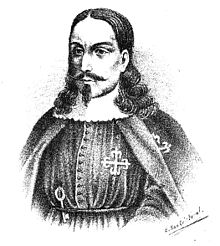Pedro Álvarez de Toledo y Leiva
|
Don Pedro Álvarez de Toledo Marqués de Mancera Caballero de Alcántara |
|
|---|---|
 |
|
| 15th Viceroy of Peru | |
|
In office December 18, 1639 – September 20, 1648 |
|
| Monarch | Philip IV |
| Prime Minister | Count-Duke of Olivares |
| Preceded by | The Count of Chinchón |
| Succeeded by | The Count of Salvatierra |
| Personal details | |
| Born | c.1585 Madrid, Spain |
| Died | March 9, 1654 (aged 68–69) Madrid, Spain |
| Spouse(s) | Luisa Feijóo de Novoa María Luisa de Salazar |
| Children | Antonio Sebastián Álvarez de Toledo |
| Profession | Lieutenant General |
| Signature |  |
Pedro Álvarez de Toledo y Leiva, 1st Marquis of Mancera (c. 1585–1654), was a Spanish nobleman, general, colonial administrator, and diplomat. He served as Captain General of Galicia and Viceroy of Peru from December 18, 1639 to September 20, 1648.
Pedro de Toledo was the son of Don Luis de Toledo, 4th Lord of Mancera, and of his second wife Isabel de Leiva. He served with the Spanish armies in Italy, rising to the rank of lieutenant general in the royal galleys of Sicily.
King Philip IV of Spain raised his title from Lord to Marquis of Mancera in 1623. Thereafter he served eight years as governor and Captain General of Galicia.
Pedro de Toledo was named the 15th Viceroy of Peru in 1639, at the age of 54. He traveled to the Viceroyalty of Peru with his son Antonio Sebastián de Toledo, who later became the Viceroy of New Spain (1664–73) and 2nd Marquis of Mancera.
As viceroy, Pedro de Toledo introduced the papel sellado (literally, sealed paper). He expanded the naval forces and fortified the ports of Valdivia, Valparaíso, Arica and Callao. In Callao he ordered the construction of a 4 kilometres (2.5 mi) long defensive wall, which was completed in 1647. Isla Mancera, an island at the mouth of the Valdivia River, is named after him.
He organized literary discussion parties, tertulias a formalized kind of official salon. In these was introduced the mancerina, a ceramic or silver saucer with a framework for holding a jícara, or chocolate cup. The manufacture of mancerinas later became an industry in the Spanish towns of Manises and Talavera.
...
Wikipedia
